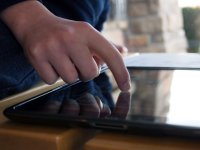Take Note: How to Curate Learning Digitally
Going beyond the 4Ss of digital note taking (support, save, search, and share), students should work toward curating, synthesizing, and reflecting on their learning.
Your content has been saved!
Go to My Saved Content.Note taking lies at the heart of curricula around the world. Beginning in elementary school, we teach students to "take notes" so that they can maintain a record of the content disseminated to them by the teacher. And yet, with mobile devices replacing paper notebooks, this process has become increasingly complex as students (and teachers) struggle to apply previous strategies to new tools.
In the past, I wrote about the 4Ss of Note Taking With Technology. Students should choose a system that:
- Supports their learning needs
- Allows them to save across devices
- Possesses search capabilities
- Can be shared
While I realize that younger students need scaffolding to learn any system, older students need to think beyond just transcribing information. In an age when simple facts can be Googled and students create with a combination of analog and digital tools, they need to think about note taking as an opportunity to curate and synthesize information so that they can make conclusions, build deeper understanding, and construct new knowledge. Whether students choose to handwrite, sketch, or type their notes, the challenge lies not in choosing, but in creating a system that allows them to ultimately curate, synthesize, and reflect on what they learn.
Curate
Recently, a middle-school teacher mentioned to me that her students could not keep track of everything. In this 1:1 iPad school, students possessed paper notebooks, Google Docs, Explain Everything projects, Notability notes, and media files created in a number of other apps. With all of these disparate learning artifacts, the students struggled to find things and make sense of their learning. They lacked a system to curate all of this content in one place in order to effectively organize and make sense of it. Beyond just throwing notes and handouts into a Google Drive folder, they needed a digital home for all of their learning.
Curation implies more than just collecting resources into a folder or notebook. It assumes a level of thoughtfulness as the curator considers the value that each artifact possesses within the context of the overall experience. Last year, Sabba Quidwai, Director of Innovative Learning at Keck USC Medical, tackled the issue of curation with her physician assistant students. She worked with them to develop a system using Evernote. Whether her students annotated presentation slides in Notability, wrote in a paper journal, or posted to an online discussion, they ultimately curated all of their content into Evernote notebooks as links, PDFs, photos, or text so that every artifact had a home.
Beyond just organizing this content into notebooks, Sabba asked her students to also add a quick reflection and consciously think about how they might tag each note so that they could ultimately see relationships across content areas. Students might type, handwrite, or even use audio to record their thinking -- choosing a medium that best supports their learning in various subjects.
Synthesize
Beyond just describing the contents of each note, Sabba wanted her students to make connections, ask deeper questions, and construct new understandings based on how they considered their curated content. In other words, she wanted her students to synthesize their understanding and draw new conclusions.
In the previously mentioned iPad school, students could use Notability much like Sabba’s students incorporated Evernote, curating their content in notes and then synthesizing their thinking in text, handwriting, or audio. They could also curate content in Google Drive and then synthesize the contents of each folder in hyperlinked Google Docs.
Either tool will suffice as long as the students take the time to make connections and add their reflections. By consciously synthesizing their notes, regardless of how they generated the initial copy, students can begin to create a means to search not just the keywords or titles, but also their own thinking.
Reflect
For the first time in 14 years, I am a student again -- and in an online program. Before beginning classes, I had to ask myself, "How am I going to manage all that I learn?" Beyond just taking notes, I will have hundreds of articles to read, dozens of papers to write, online discussion posts to share, and a variety of projects.
In terms of the 4Ss, I need a system that allows me to save between my Mac, Chromebook, iPad, Surface Tablet, and phone. I need to handwrite my notes rather than type them in order to support my learning. Though I need to be organized in a linear fashion for each course, I also require the capability to search across that organization. Finally, I want to make sure that I can share my notes with colleagues. After much consideration, I chose OneNote as my note-taking platform.
Reading notes, lecture notes, discussion posts, assignment drafts, brainstorms -- everything ends up in my OneNote notebook. I use this platform as an opportunity to construct my knowledge and understanding whether as typed or handwritten content. Each time I add a new element, I consider how the concept links back to something that I already knew. At any point in time, I can search through this notebook to see what I have learned and then ask more questions about what I still need to discover.
Students may choose to work on paper as well as digitally, taking photos to merge the two together. However, without careful consideration of curation, synthesis, and reflection, they may confuse the process rather than enhance it. Regardless of whether students prefer to initially take notes in physical or digital media, they need an opportunity to organize their work and connect ideas across the curriculum. At that point, the process shifts from simply transcribing notes to archiving learning.
What are your thoughts about and experiences with digital curation?
